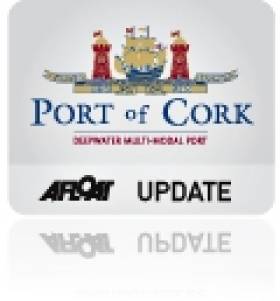Displaying items by tag: paintings
Collection of Port of Cork Paintings Feature Tall-Ships at the Crawford Art Gallery
Underway is National Heritage Week with ongoing events to include The Port of Cork Company (PoCC) which is delighted to host an event celebrating its 250-year history, at The Crawford Art Gallery in Cork, which was built in 1724 as the original Cork’s Custom House.
In commemoration of this heritage, the Port of Cork Company gifted a significant collection of maritime paintings and artefacts, known as The Port of Cork Collection, worth an estimated €1 million to The Crawford Art Gallery in November 2021.
Guests were offered a guided tour of The Port of Cork Collection, to learn about the Port’s history and how it has played a vital role in keeping Cork connected as an international gateway for trade for many centuries.
Speaking at the event, Eoin McGettigan, Chief Executive Officer with PoCC, stated “As a company, we are very proud of our heritage, which spans over 250 years. These unique maritime artworks, by renowned artists, offer a fascinating insight into the operations of Cork Harbour at that time and underscore The Port of Cork’s long-standing international significance for commerce and trade."
He added "not only does the collection signify the history of our great port and harbour, but it also showcases how far the port has come, in terms of leisure, operations, scale and trade. We are delighted this collection has found such a welcoming home at The Crawford Art Gallery over the past 6 months.”
The Cork has more on the exhibition (running to 28 August) of 17 paintings on display that date to the 1800's to include a Cobh-born artist.
Port of Cork Maritime Collection Opens
#portofcork – The Port of Cork Maritime Collection, an exhibition of maritime themed paintings and models is now open at the Sirius Arts Centre, Cobh. The exhibition, which will run until 22nd July, will showcase a selection of the Port's historic maritime art pieces dating back from the 1800s. Highlights of the collection include a number of paintings by marine artist George Mounsey Wheatley Atkinson and Robert Lowe Stopford who is known for his series of panoramic views of Queenstown.
This exhibition offers the public a chance to view this one of a kind collection of paintings and models which are usually housed in the Port's headquarters in Custom House. In 2005, to celebrate Cork's year as Capital of Culture, the Port of Cork hosted an exhibition of maritime art dating back to the 1700s which drew hundreds of visitors from far and wide. In 2010, paintings also went on loan to Dachau museum for an exhibition which formed part of a year-long commemoration of the life and works of renowned Cork composer and conductor Aloys Fleischmann. More recently, in April 2012, paintings went on loan to Belfast Port to form part of their 'Kings of the Tides' exhibition.
Speaking about the exhibition, Chief Executive of the Port of Cork Brendan Keating said "The Port of Cork is delighted that we are able to share our exceptional collection of paintings and models with the people of Cork and beyond. These works give us a glimpse of how our harbour has changed over the years and also reminds us of the rich history of Cork's shipping business. I would like to thank Sirius Arts Centre for hosting our collection and to Peter Murray and the Crawford Gallery for making this exhibition possible."
Entry to the exhibition is free of charge.
For further information, see www.siriusartscentre.ie or phone 021 4813790.
Gallery Opening Hours:
Wednesday – Friday: 11AM - 5PM
Saturday & Sunday: 2PM - 5PM
Monday & Tuesday: Closed





























































